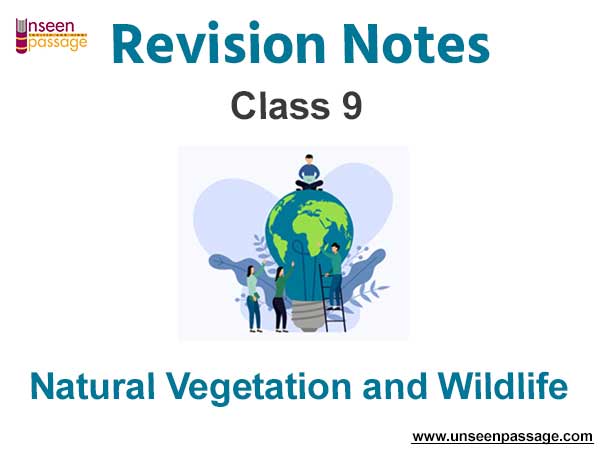Natural Vegetation and Wildlife Class 9 Social Science Notes
• With over 47,000 plant species, India occupies tenth place in the world and fourth in Asia in plant diversity.
• India has 89,000 species of animals as well as a rich variety of fish in its fresh and marine waters.
• Plant community which grows naturally with no human help and is not disturbed by humans for a long time is teemed as natural vegetation.
• Virgin vegetation which are purely Indian are known as endemic species and those which have come from outside India are termed as exotic plants.
Relief
• The nature of land influences the type of vegetation.
• Different types of soils provide basis for different types of vegetation.
Climate
• The character and extent of vegetation are mainly determined by temperature along with humidity in the air, precipitation and soil.
• Period of exposure to sunlight varies for different plants leading to their different rates of growth.
• Areas of heavy rainfall have more dense vegetation as compared to other areas of less rainfall.
• Forests are renewable resources and play a major role in enhancing the quality of the environment.
• Vegetation in most parts of India has been modified at some places, or replaced or degraded by human occupancy.
Ecosystem
• All the plants and animals in an area are interdependent and interrelated to each other in their physical environment, thus forming an ecosystem.
• A very large ecosystem on land having distinct type of vegetation and animal life is called a biome.
Types of Vegetation
• The major types of vegetation in India are Tropical Rainforests, Tropical Deciduous Forests, Tropical Thorn Forests and Scrubs, Montane Forests and Mangrove Forests.
• With warm and wet climate all year round the Tropical Rainforests have luxurious trees, shrubs and creepers.
• A large variety of animals are found in the rainforests.
• The most widespread forests of India — the Tropical Deciduous Forests — are also known as the Monsoon Forests.
• On the basis of the availability of water, these forests are further divided into moist and dry deciduous forests.
• The leaves of vegetation in Thorn Forests and Scrubs are mostly thick and small to minimize evaporation and have succulent stems to conserve water.
• Montane forests have a succession of natural vegetation belts in the same order as we see from the tropical to the Tundra region.
• Wet temperate forests are found between a height of 1000 and 2000 metres while temperate grasslands are found at higher elevations.
• At 3600 metres above sea level temperate forests and grasslands give way to alpine vegetation.
• The mangrove tidal forests are found in the areas of coasts influenced by tides.
• Dense mangroves are the common varieties with roots of the plants submerged underwater.
Wildlife
• India has more than 1200 species of birds, 2500 species of fish and between 5 to 8 per cent of the world’s amphibians, reptiles and mammals.
• India is the only country in the world that has both tigers and lions.
• The Himalayas have a large range of animals that survive the bitter cold.
• Every species of animal has a role to play in the ecosystem; hence conservation is essential.
• Hunting and pollution is causing threat to animal species.
• To protect the flora and fauna of the country, the government has taken many steps.
• Fourteen biosphere reserves have been set up in the country to protect flora and fauna.
• 89 National Parks, 49 Wildlife Sanctuaries and Biosphere Reserves have been set up to take care of natural heritage.




